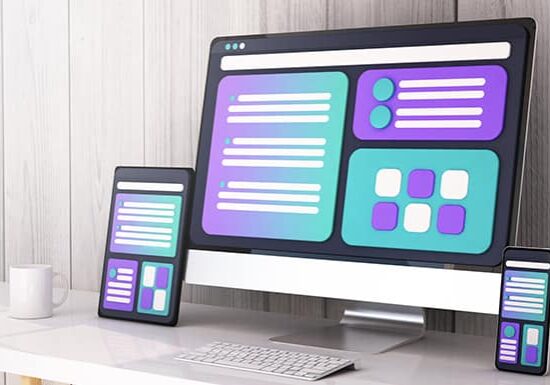How to Become a Web Designer: Step-By-Step Guide
Updated: January 16, 2024
Published: June 9, 2021

Have you always wondered what it takes to become a web designer? Web designers are becoming more in demand as businesses shift a lot of their focus online, so this is an exciting career to get into.
You might even be surprised to learn that you don’t necessarily need a degree to become a web designer. A lot of people in the industry are actually self-taught. Still, you will need plenty of practice as well as the right skills to succeed as a web designer.
Let’s take a closer look at web design as a career, including the skills you’ll want to acquire and the steps you’ll need to take to start working as a web designer.
Source: Pexels Alt text: Computer setup of a web designer
What Does a Web Designer Do?
The role of a web designer is to design new websites or update existing ones using a combination of their technical and creative skills.
As a web designer, your task will be to build or design every element of a website, including fonts, layouts, color schemes, and other visual elements. The goal is to make a website not only look visually attractive, but also to ensure that it’s user-friendly.
Aside from designing a website, here are some of the other tasks web designers do on a regular basis:
- Consulting their clients on what they want from their site
- Creating websites that reflect a client’s branding colors, fonts, style, etc.
- Preparing design plans before beginning the website design process
- Adding buttons, pictures, links, and multimedia items to a site’s layout
- Testing the website for functionality and for bugs
- Uploading the website when it’s ready to be published live
Average Web Designer Salary
As a web designer, the salary you earn will be relative to your experience, so it’s in your best interest to build up your portfolio as much as possible while you’re learning the skills before going pro.
According to Career Explorer, beginner web designers earn an average of $28,273 annually, while top-level designers earn about $73,017 per year. That’s a pretty big discrepancy, so clearly experience matters a lot in this field. Your salary can also change depending on where you work, like at a firm or agency, or if you’re a freelance web designer setting your own rates.
Web Designer vs Web Developer: What’s the Difference?
Often, people use these two terms interchangeably, and while there are many similarities between each role, there are some differences to note.
While many of the tasks of web designers and web developers often overlap, most people will choose to specialize in one role or the other. For the most part, web designers are more focused on a website’s stylistic and visual elements while a web developer will be more concerned with its functionality and usability.
In other words, a web designer focuses more on the front-end of a site, and a web developer might work more on coding and programming in the back-end. Again, it’s possible for both designers and developers to do both, but it depends on the requirements of a project.
How to Become a Web Designer
Source: Pexels Alt text: Woman on laptop learning web design skills
Now that you know a little more about the job itself, you’re probably wondering how to become a web designer. Luckily for you, we’ve put together a quick step-by-step guide to help provide you with some direction on how to get started in this exciting career.
Learn the skills
You obviously need a lot of technical skills in order to be a web designer, so the first step on your journey is to start learning them. You can do this through specific courses, or even by completing a degree, though that’s not always necessary.
You’ll want to get comfortable with graphic software, learn some basic programming languages, and learn about web design theory. We’ll go over more of the specific skills you’ll need a bit later.
Get certified
Like we said earlier, you don’t necessarily need a degree, but it would help immensely to get some certifications. Getting certified will not only help you gain more experience, but you’ll also be able to demonstrate to potential clients that you’re qualified for the role.
Here are a few of the certifications you can consider getting:
Get the right tools
After learning some skills and gaining certifications, you want to set yourself up for success by collecting the best industry tools. Certain software programs are essential, so you’re going to want to make sure you have a subscription and that you know how to use them.
Some of the tools you’ll likely need include Adobe Photoshop for your graphics editor, Mockplus for prototyping, and Atom or Sublime for your coding editor.
Build your portfolio
A varied and strong portfolio can help you land jobs and build up experience along the way, so this definitely isn’t a step you want to skip. As you take on more projects, keep a regularly updated portfolio of your work.
It’s a good idea to outline what the client requested and what you delivered so new clients can get a better view of how you work. Then, you can use this portfolio to email to potential clients when they ask for samples.
Market yourself
Knowing the ins and outs of designing a website isn’t the only skill you’ll need. An essential step in becoming a successful web designer, especially if you plan on freelancing, is knowing how to market yourself to new clients.
Your portfolio is a good place to start, but you should also start building your network and relying on social media to gain more visibility.
Furthermore, always communicate openly with your existing clients so that they enjoy working with you and recommend you to others.
Find a specialization
While this isn’t a necessary step, by specializing in a specific area you can find more niche clients, gain more expertise in certain skills, and even charge more for your services. You might want to consider specializing in specific types of web design, such as creating e-commerce sites, focusing on mobile websites, or even on a type of business.
Stay on top of trends
As a web designer, learning is never over. Think of how different website design has evolved from the 90s compared to what we expect of websites today. That’s why it’s so important to continuously stay on top of emerging design trends. Not only will you be better able to deliver the most cutting-edge websites to your clients, but you’ll ensure that your work stays relevant over time.
Skills You’ll Need to Become a Web Designer
There are tons of possible skills you can acquire when becoming a web designer. Some are more niche than others, and some are a lot more involved.
In addition to technical skills, you’ll also need some soft skills in order to run a business effectively, especially if you want to be an independent web designer.
Here’s a non-exhaustive list of some of the skills you should learn when becoming a web designer:
- User experience (UX)
- Visual design
- HTML & CSS
- How to use design software
- Javascript
- Communication skills
- Time and project management
- SEO basics
- Business management
Final Words
Becoming a web designer isn’t necessarily complicated, but it takes a lot of focus, passion, drive, and practice to become an expert in the field. With our steps on how to get started, you can learn web design at your own pace and then apply your knowledge to your new business.
If you want to learn web design or development in greater depth, or if you want to grow other skills that will enable you to create software or become a better programmer, then consider doing a bachelor’s degree.
At University of the People (UoPeople), we offer a tuition-free Computer Science bachelor’s or associate’s degree. The degree is entirely online, so you can still continue working as a web designer while picking up even more skills.


